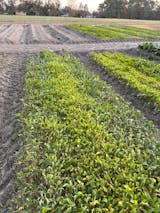Kodiak Brown Mustard
- Kodiak Brown Mustard – Cool-season cover crop used as a biofumigant.
- Helps reduce soil pests, pathogens, and diseases.
- "Hotter" than Florida Broadleaf Mustard, making it more effective as a biofumigant.
- Not edible, specifically used for soil improvement.
- Excellent cover crop prior to planting potatoes.
- Brassica juncea.
We have run out of stock for this item.
Description
Kodiak Brown Mustard is a cool-season cover crop that works great as a biofumigant for managing soil pests, pathogens and disease. As opposed to Florida Broadleaf Mustard which can also be harvested as a food crop, Kodiak Brown Mustard is strictly a cover crop used for biofumigation purposes. It is significantly "hotter" or "spicier" than traditional broadleaf mustard. This means that its effectiveness as a biofumigant is also much greater. It also produces more biomass than traditional broadleaf mustard.
For effective biofumigation, Kodiak mustard must be chopped and incorporated into the soil. This releases glucosinolates which are involved in the natural fumigation of the soil. We recommend tilling into the soil or mowing and tilling directly after. The sooner you can get the plant biomass into the soil layers, the more effective it will be. Studies have shown that Kodiac Brown Mustard is a great cool-season cover crop to grow prior to spring potato planting. Trials indicated that a cover crop of brown mustard was similarly effective as chemically fumigated fields with potato rotations. It is also a great crop to grow prior to planting English Peas in the spring.
In addition to being a biofumigant, brown mustard does a great job of conditioning soils. Roots can penetrate 1-3' deep in some instances, providing aeration and softening soils for future plantings. During the flowering stage, the yellow flowers do a phenomenal job of feeding pollinators and attracting beneficial insects. Mustard flowers are known to attract considerable populations of hoverflies and ladybugs, which feed on aphids and other garden pests.
Kodiak Brown Mustard can be grown in fall or early spring. We suggest planting in early/mid-fall with enough time for plants to establish before frost arrives. The seed can be broadcast and covered or planted with a precision planter like our Hoss Garden Seeder. As with all cover crops, mustard should be cut or mowed before going to seed to prevent any residual weed issues. Once cut, incorporate into the soil as green manure for best results. Mustard can also be used as forage and works great as a component of a food plot mixture.
Kodiak Brown Mustard Planting Information:
Season: Cool
Planting Depth: 1/4"
Seeding Rate: 0.5 lb per 1,000 sq. ft.






